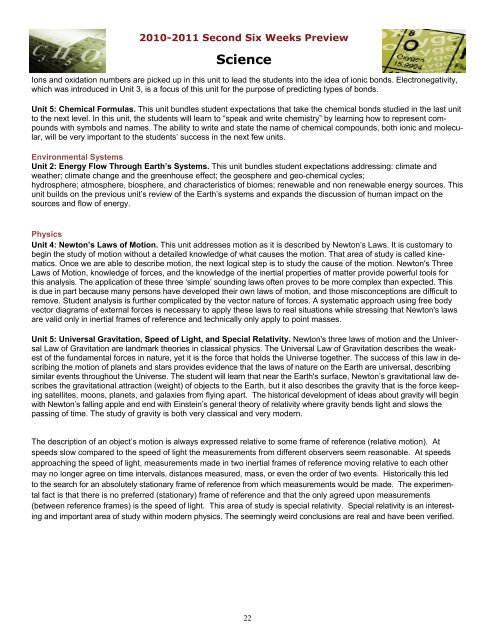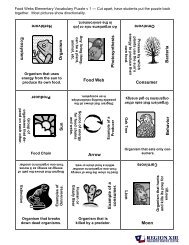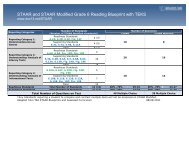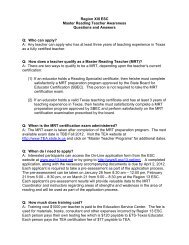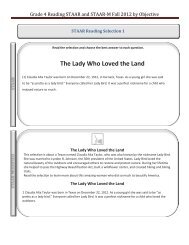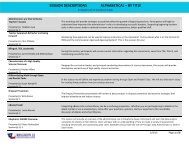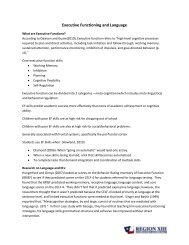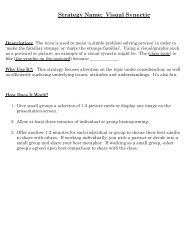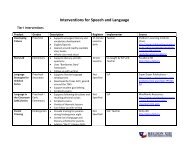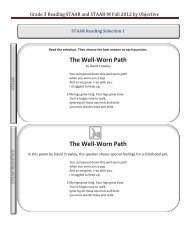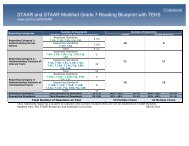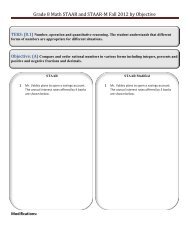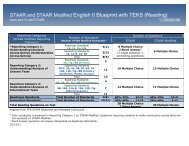2nd Six Weeks Newsletter - Region 13
2nd Six Weeks Newsletter - Region 13
2nd Six Weeks Newsletter - Region 13
Create successful ePaper yourself
Turn your PDF publications into a flip-book with our unique Google optimized e-Paper software.
2010-2011 Second <strong>Six</strong> <strong>Weeks</strong> PreviewScienceIons and oxidation numbers are picked up in this unit to lead the students into the idea of ionic bonds. Electronegativity,which was introduced in Unit 3, is a focus of this unit for the purpose of predicting types of bonds.Unit 5: Chemical Formulas. This unit bundles student expectations that take the chemical bonds studied in the last unitto the next level. In this unit, the students will learn to “speak and write chemistry” by learning how to represent compoundswith symbols and names. The ability to write and state the name of chemical compounds, both ionic and molecular,will be very important to the students’ success in the next few units.Environmental SystemsUnit 2: Energy Flow Through Earth’s Systems. This unit bundles student expectations addressing: climate andweather; climate change and the greenhouse effect; the geosphere and geo-chemical cycles;hydrosphere; atmosphere, biosphere, and characteristics of biomes; renewable and non renewable energy sources. Thisunit builds on the previous unit’s review of the Earth’s systems and expands the discussion of human impact on thesources and flow of energy.PhysicsUnit 4: Newton’s Laws of Motion. This unit addresses motion as it is described by Newton’s Laws. It is customary tobegin the study of motion without a detailed knowledge of what causes the motion. That area of study is called kinematics.Once we are able to describe motion, the next logical step is to study the cause of the motion. Newton's ThreeLaws of Motion, knowledge of forces, and the knowledge of the inertial properties of matter provide powerful tools forthis analysis. The application of these three ‘simple’ sounding laws often proves to be more complex than expected. Thisis due in part because many persons have developed their own laws of motion, and those misconceptions are difficult toremove. Student analysis is further complicated by the vector nature of forces. A systematic approach using free bodyvector diagrams of external forces is necessary to apply these laws to real situations while stressing that Newton's lawsare valid only in inertial frames of reference and technically only apply to point masses.Unit 5: Universal Gravitation, Speed of Light, and Special Relativity. Newton's three laws of motion and the UniversalLaw of Gravitation are landmark theories in classical physics. The Universal Law of Gravitation describes the weakestof the fundamental forces in nature, yet it is the force that holds the Universe together. The success of this law in describingthe motion of planets and stars provides evidence that the laws of nature on the Earth are universal, describingsimilar events throughout the Universe. The student will learn that near the Earth's surface, Newton’s gravitational law describesthe gravitational attraction (weight) of objects to the Earth, but it also describes the gravity that is the force keepingsatellites, moons, planets, and galaxies from flying apart. The historical development of ideas about gravity will beginwith Newton’s falling apple and end with Einstein’s general theory of relativity where gravity bends light and slows thepassing of time. The study of gravity is both very classical and very modern.The description of an object’s motion is always expressed relative to some frame of reference (relative motion). Atspeeds slow compared to the speed of light the measurements from different observers seem reasonable. At speedsapproaching the speed of light, measurements made in two inertial frames of reference moving relative to each othermay no longer agree on time intervals, distances measured, mass, or even the order of two events. Historically this ledto the search for an absolutely stationary frame of reference from which measurements would be made. The experimentalfact is that there is no preferred (stationary) frame of reference and that the only agreed upon measurements(between reference frames) is the speed of light. This area of study is special relativity. Special relativity is an interestingand important area of study within modern physics. The seemingly weird conclusions are real and have been verified.22


